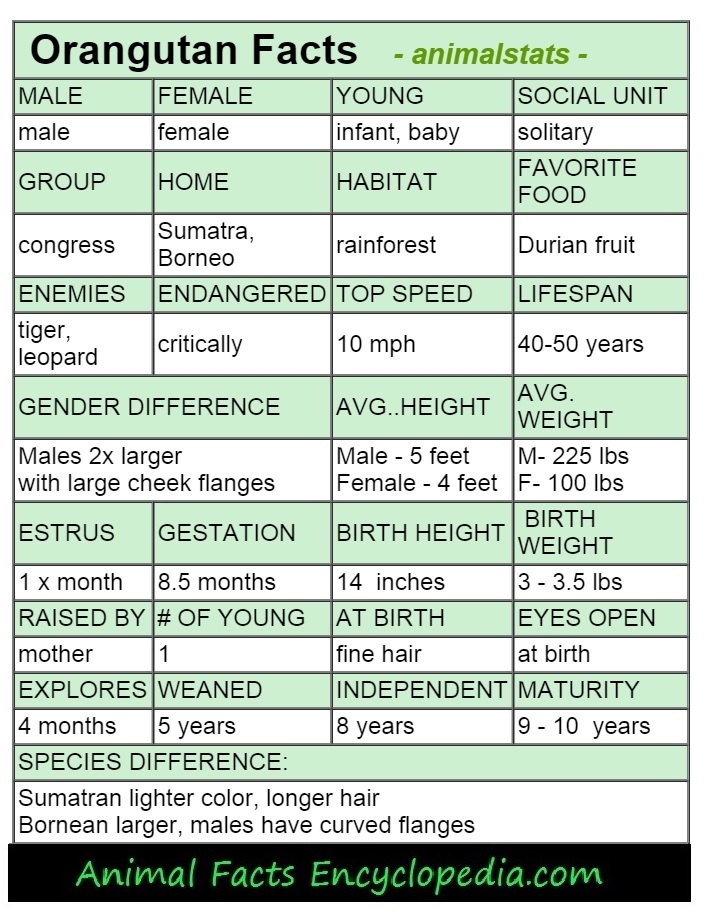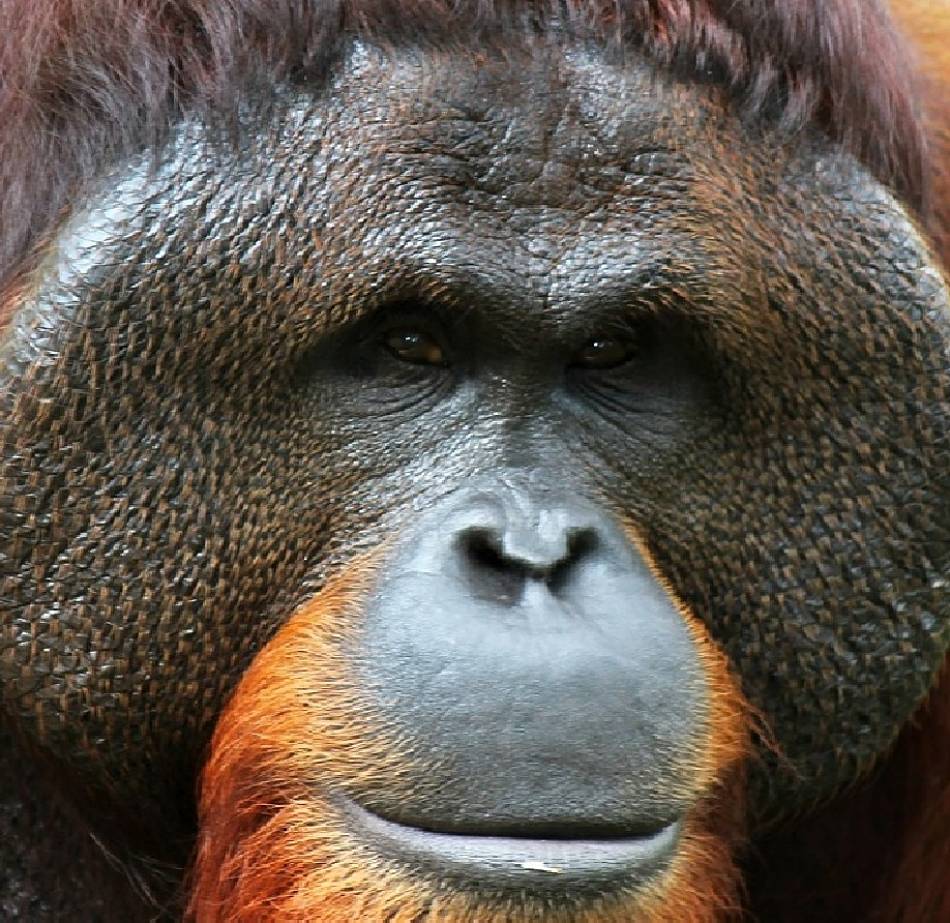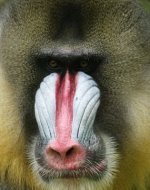orangutan Facts
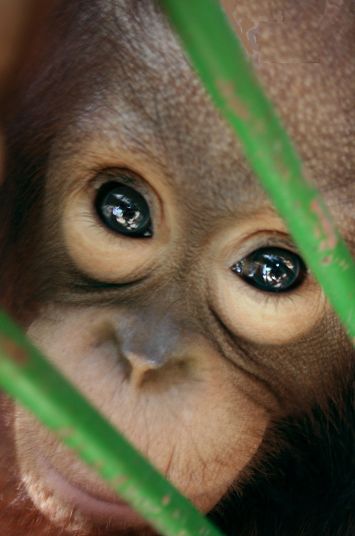 Portrait of an Orangutan
Portrait of an OrangutanAlthough the word orangutan may sound like a reference to the orangutans orange colored hair, it is actually a combination of two Malaysian words "orang" meaning "person" and "hutan" meaning "forest".
These "people of the forest" are one of our closest relatives sharing over 96% of our DNA.
Orangutans are the largest arboreal animals in the world and spend the vast majority of their time in the rainforest canopy. They eat, sleep, breed and give birth, sometimes hundreds of feet above the ground.
They are climbing machines, with remarkably long and powerful arms, and feet with opposable big toes that have a grip strength 4 times that of a human hand.
Cumbersome and graceless on the ground, even the largest male orangutans are aerial artists in the trees.
Orangutans and tropical rainforests were once plentiful all across the Southeast of the continent of Asia, but today, only two small populations of two separate species of orangutan remain.
The Sumatran orangutan, which can be found only on the Indonesian island of Sumatra, is lighter in color with longer hair than the Bornean orangutan.
The Bornean species can be found only on the Malaysian island of Borneo. Bornean orangutans have darker hair and males have more pronounced cheek flanges that curve forward.
There is considerable sexual dimorphism in the orangutan with males generally growing to at least 2 times the weight of females.
Males start to develop large cheek "flanges" when they are in their teens. The flanges are thick pads of flesh that frame the face and develop more prominently in dominant males. Some less dominant males never develop cheek flanges.
The orangutan is the only member of the great apes that does not live in large groups. Females raise their infants and have their company for up to ten years, but adult males live solitary lives with little socializing.
Seasonally, groups of adults may come together at select fruit trees, and young females may "hang out" together for a few days at a time, but mostly these "people of the forest" are loners. - Orangutan Facts
the spectacular face
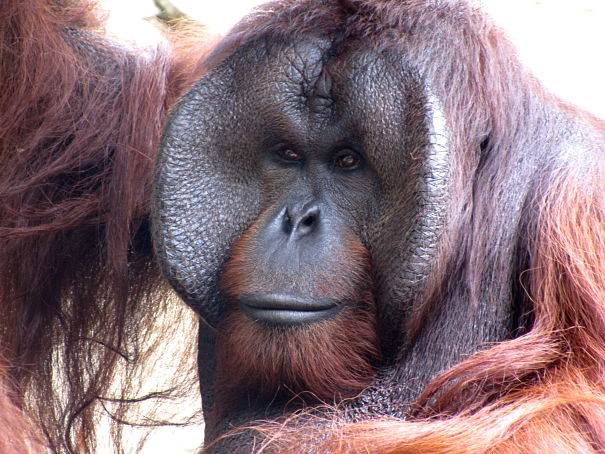
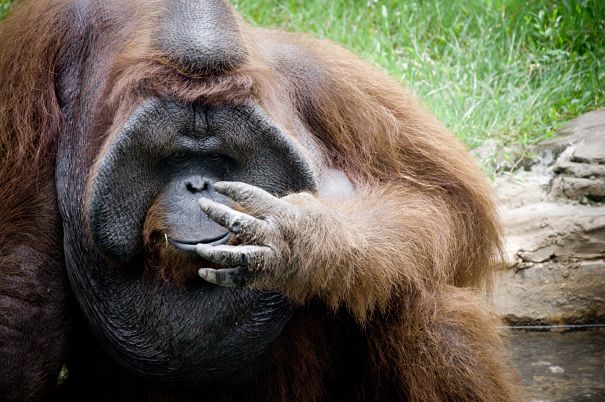
When it comes to examples of great ape masculine extreme, the gorilla has the silverback, the human being has 'The Rock,' but only the orangutan has the flange.
Young male orangutans look just like their female counterparts until about the age of twelve, and then they begin to develop fatty deposits on their cheeks in the shape of large semi-circles. They also develop a large deposit of fat on the top of the skull, and a large throat pouch that allows them to create very loud warning yells called "long calls."
The flanges of the Bornean orangutan in particular, are sometimes quite massive, and curl in towards the face. One theory on this curved shape is that it may act as a sounding board for the long calls.
Sumatran males flanges are smaller and flatter, but they develop a long "cape" of hair that hangs from their arms and looks very cool when they are swinging through the trees.
Adult male orangutans have loosely defined territories that overlap with other males, and usually includes the territories of several females with their infants.
The calls they sound out across the rainforest serve notice for other males to keep clear.
Occasionally confrontations occur, but are rarely serious. When fights between mature males do occur though, they often include them biting each others flanges.
The most interesting part of all of this, is that not all males develop flanges. There is no real understanding of why this is, but "un-flanged" male orangutans seem less dominant, and are often considerably smaller.
They may still find receptive females however, and so the flanged male is not really "alpha" in the sense that it dominates breeding.
In the most interesting twist to this orangutan tale, there have been several documented cases of orangutan populations in captivity that had one flanged male in residence. When he was removed or passed on, the unflanged male rapidly developed a full face of flanges - fascinating! - Orangutan Facts
orangutans in peril
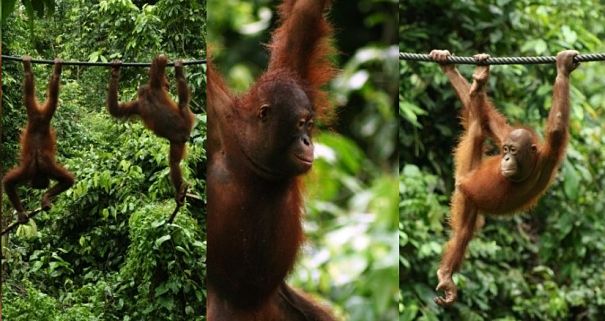 ninja warriors
ninja warriors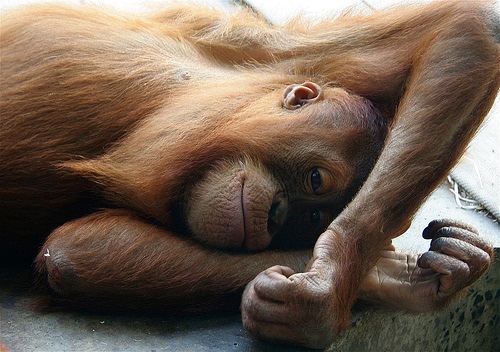 beautiful young orangutan
beautiful young orangutanThe wonderfully expressive and soulful orangutan, is now limited to two tiny islands and about 60,000 wild individuals.
There are many different studies and conservation efforts occurring simultaneously to save the wild orangutan, but the task starts, of course, with saving the rainforests they call home.
Recently, the most pressing force against the survival of the orangutan has been the development of palm oil plantations.
Thousands of items that we use every day, from shampoo to ice cream, contain palm oil as an ingredient, and the demand is on the rise for this product.
Believe it or not, one of the reasons for the increase in the use of palm oil is the health craze in developed nations. The use of trans-fats in many notoriously unhealthy snack foods is being replaced with palm oil.
These plants are actually native to Africa, but are being grown and supplied to the industry enmasse by plantations in Borneo and Sumatra. In order to start growing the palm, thousands of acres of rainforest are burned to the ground.
Sometimes communities of orangutans and hundreds of other animals are killed in the process. Sometimes communities of indigenous peoples are displaced as well, and all for a healthier snack.

orangutan reproduction
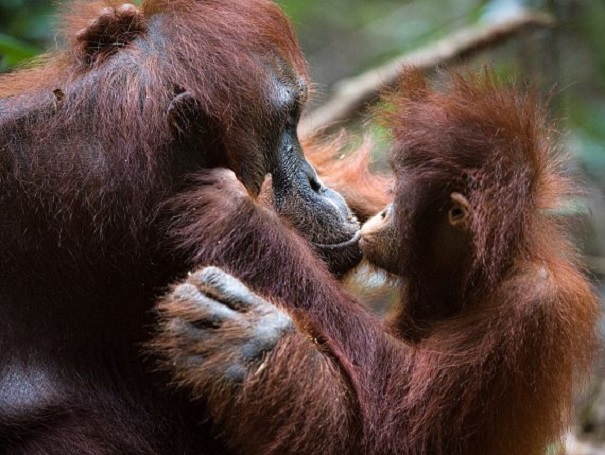 oranguatn mother and baby kissing
oranguatn mother and baby kissing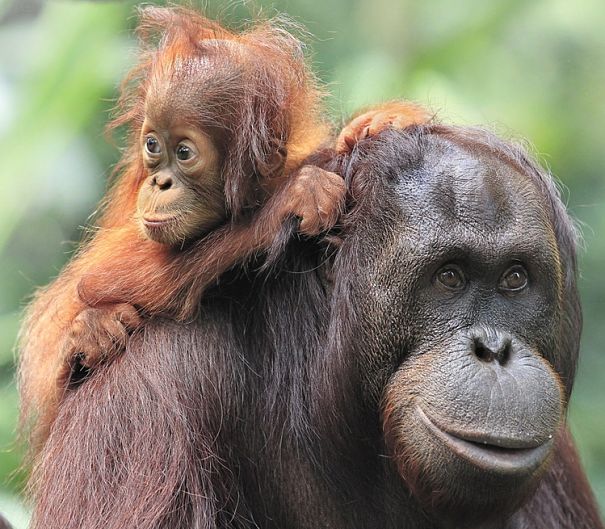 infant orangutan - baby on board!
infant orangutan - baby on board!The orangutan has a very long childhood, similar in length to humans and elephants.
It is probably one of the most intense mother-child bonds, and youngsters don't tend to "leave the nest" until they are about 10 to 12 years old. Mothers may have become pregnant and given birth to another infant while they are still caring for one, and little "families" of varying ages are not uncommon.
Although the dependency on the mother is very long, once they head off on their own, orangutans tend to become sexually active fairly quickly. Orangutans generally mate when the female is in cycle, but like human beings and bonobos, they occasionally engage in sexual activity of a more recreational nature.
Even pregnant females have been observed engaging in sexual activity.
Beyond that, and most unusual, orangutans regularly have intercourse face-to-face. Whales do this of course, but among land animals it was once thought that only humans had sex in this position.
Observation has revealed that both orangutans and their very sexy cousins the bonobos also have face-to-face relations, and while nowhere near as sexually active as bonobos, orangutans use this position more often percentage wise than any animals other than human beings.
Young female orangutans usually have their first infant at about 14 years of age. Males must wait a bit longer to mature, but a dominant young male who is aggressive, develops impressive flanges and begins to "long call" to announce his presence, can attract a willing female by the time he is 15 or 16.
Females cycle every month and are receptive for about 4 days, during which they will nest with the male of their choice. There are some altercations between males for territory and mating rights, and most older males display small scars and injuries as they age, often on their flanges.
These altercations involve loud bellows, slapping and biting, and a style of shoving similar to Sumo wrestlers, but are rarely, if ever, fatal
Once pregnant, the female prepares a particularly elaborate nest which may actually include more than one level for her to store food or just move about.
She gives birth 100 feet off the ground, and her newborn although wide-eyed and furred, is virtually helpless. Infant orangutans have one pressing goal- to grab onto mom as tight as possible.

They have long, strong fingers and toes that lock on the hair of their mothers chest and belly for the first two weeks, and then grasp her head, and neck hair for a ride on her back.
The youngster may be carried for up to four years, and will nurse for up to six. Mother orangutans spend time carefully teaching their youngsters the intricacies of rainforest life.
They chew fruits and offer bits from their mouth for the baby to sample.They demonstrate how to open a wide assortment of seeds and nuts. They move about their territory demonstrating where, when and which trees have the best bounty. They use simple tools like sticks that they have removed the leaves from to catch ants and termites, and they carefully demonstrate these skills.
Most importantly, they pass on the skills of nest building.
Nest building for orangutans is virtually an art, and they build the most elaborate nests of all the great apes, sometimes even including blankets and pillows.
Youngsters spend years learning the craft, first assisting mother, then attempting their own nest off to the side. At 8 years or so, many young orangutans are building their own nests every night and sleeping next to their mother.
The mastery of nest building is a major milestone for the youngster who will soon head out to start adult life..
a life in the trees
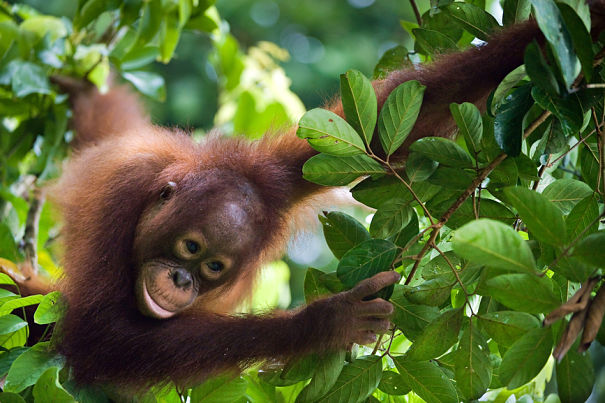
As the worlds biggest tree-dwelling animal, large male orangutans can reach heights of well over 5 feet and weights of over 250 pounds, but they are like slow-motion acrobats when they make their way through the rainforest canopy.
With all of their food sources in the trees, orangutans have little reason to come down to earth. The thick connection of canopy trees form a continuous highway above the ground sometimes miles long.
Orangutans get the majority of the moisture they need from their fruit-filled diet, but drink fresh rainwater that has collected in the crooks of trees and on large leaves as well The Sumatran orangutan almost never comes down to the ground, except when water is scarce.
The bornean orangutan spends a little more time on the ground, and even females with youngsters may occasionally be found on the forest floor.
The most probable reason for this difference is the lack of tigers on the island of Borneo. Tigers are by far the biggest predator of orangutans in Sumatra, but on Borneo the greatest threat to adult orangutans is crocodile, and youngsters who wander too far may occasionally fall prey to clouded leopards..
When they do come to the ground they walk on all fours and appear very cumbersome. They may also scoot about on their rumps.
Orangutans are not knuckle-walkers like gorillas and chimps but instead walk on their palms or balled-up fists. In the trees their long curved fingers and toes serve as hooks to latch on from branch to branch in a style of locomotion called "brachiation".
When making their way through thin vines or flimsy vegetation the fingers are so long that they can curl around smaller branches almost 1 1/2 times to secure themselves. The tops of the first two digits of each finger lock against the inside of the palm in an orangutan super-grip.
Infants are born with this gripping instinct and can hold on to thin strands of hair with ease.

orangutan intelligence
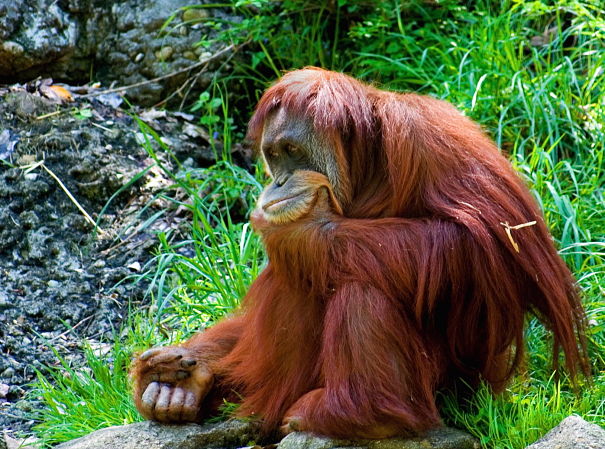 Sumatran orangutan deep in thought
Sumatran orangutan deep in thought
All the great apes are extremely intelligent creatures, but the question of which non-human great ape is the most intelligent is often asked.
Among the great apes the gorilla, the bonobo and the orangutan live relatively peaceful lives compared to human beings and chimpanzees, and it is certainly possible that levels of expected conflict in daily life create minds that emphasize different gifts.
The chimpanzee is an organized hunter, regularly uses weapons like clubs and rocks,, and is generally a more active and busy creature than the relaxed and slow-moving orangutan.
This outward spark leads many to believe the chimp is the brightest of the great apes, and in scientific experiments that involve food rewards, chimps excel, but this may be because their natural lifestyle involves strenuous competition for food.
A recent, in-depth study of orangutans done in 2011, shed some light on just how intelligent orangutans may be. At a research facility in Indonesia, scientists from the University of Manchester spent an entire year observing, documenting and filming orangutans building nests. The study concluded that orangutans possess complex knowledge of mechanical design and material properties.
They select specific types of limbs when constructing the base of the nest, smaller, more flexible branches for the sides, and even have multiple additional structures they may build such as blankets, pillows and roofs.
Their nest building skills are more complex than any of the other non-human great apes, and the techniques are carefully taught from mother to youngster.
The creation of pillows out of soft shoots, and blankets out of large leaves was unique to orangutans and the attention to detail was astounding.
Orangutans have long been known to use any available item - mostly palm leaves, as umbrellas during rain showers, but their specific style of nest construction involves a complex series of steps, including the gathering of the correct materials, that appears to represent truly advanced thinking.
a few more orangutan facts
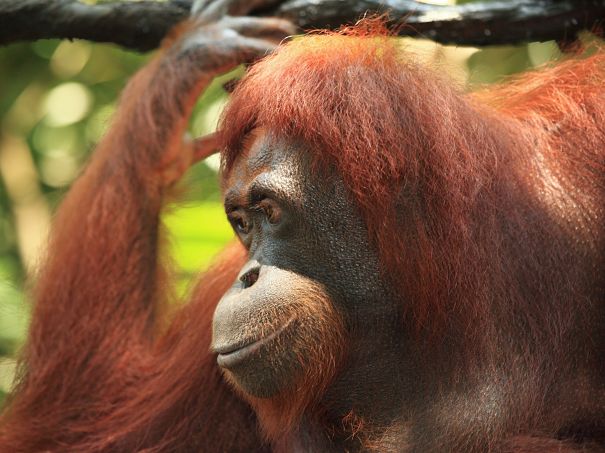
- A group of orangutans is called a "congress"
- The orangutan is the only great ape native to Asia
- Orangutans are the largest tree-dwelling animals in the world
- An orangutan has incredibly strong arms that are twice as long as its legs
- Adult male orangutans develop large "cheek flanges" that are thick pads of fat that frame their faces
- The orangutan is the only great ape that does not live in large groups
- Orangutans share about 96.4% of our DNA
- Orangutans love a fruit called Durian which smells like strong garlic
Scientific Classification:
| Orangutan Facts - animalstats - | |||
|---|---|---|---|
| MALE | FEMALE | YOUNG | SOCIAL UNIT |
| male | female | infant, baby | solitary |
| GROUP | HOME | HABITAT | FAVORITE FOOD |
| congress | Sumatra, Borneo | rainforest | Durian fruit |
| ENEMIES | ENDANGERED | TOP SPEED | LIFESPAN |
| tiger, leopard | critically | 10 mph | 40-50 years |
| GENDER DIFFERENCE | AVG..HEIGHT | AVG. WEIGHT | |
| Males
2x larger with large cheek flanges |
Male -
5 feet Female - 4 feet |
M-
225 lbs F- 100 lbs |
|
| ESTRUS | GESTATION | BIRTH HEIGHT | BIRTH WEIGHT |
| 1 x month | 8.5 months | 14 inches | 3 - 3.5 lbs |
| RAISED BY | # OF YOUNG | AT BIRTH | EYES OPEN |
| mother | 1 | fine hair | at birth |
| EXPLORES | WEANED | INDEPENDENT | MATURITY |
| 4 months | 5 years | 8 years | 9 - 10 years |
| SPECIES DIFFERENCE: | |||
| Sumatran
lighter color, longer
hair Bornean larger, males have curved flanges |
|||
see more animal extreme closeups
Recent Articles
-
African Animals - Animal Facts Encyclopedia
Oct 11, 16 10:27 PM
African Animals facts photos and videos..Africa is a wonderland for animal lovers, and a schoolroom for anyone who wants to learn about nature, beauty and the rhythm of life -
Baboon Facts - Animal Facts Encyclopedia
Oct 11, 16 10:26 PM
Baboon facts, photos, videos and information - Baboons are very distinctive looking monkeys with long, dog-like snouts and close set eyes. -
Great Apes Facts - Animal Facts Encyclopedia
Oct 11, 16 10:25 PM
Great apes facts, photos and videos..Human beings did not evolve from chimpanzees, modern chimps and gorillas do not appear in the fossil records until much more recently than homo sapiens..
